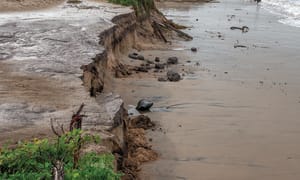WEST Gippsland Catchment Management Authority (CMA) has approved an artificial opening of Bourne Creek estuary, Kilcunda to prevent potential flooding of the Bass Highway.
The estuary opening was scheduled for Tuesday, September 3, 2024, and was undertaken by Parks Victoria at high tide, under the guidance of West Gippsland CMA Coastal Waterways Officer, Callum Edwards.
Bourne Creek estuary entrance closed naturally to the ocean last week after large swells deposited sand across the estuary entrance. Those same swells caused water levels in the creek to rise.
“It’s a careful balance. Estuary closures are natural events that provide many environmental benefits for birds, fish and the surrounding saltmarsh and wetlands. However, they also pose risks to surrounding assets by inundating farmland, cultural assets, roads and recreational infrastructure,” said West Gippsland CMA CEO Martin Fuller.
“Artificial openings are only used in conditions where it is unlikely that the estuary will naturally open to the ocean before flooding occurs, as is the current situation at Bourne Creek.”
The estuary closed due to large swells creating a sandbar, blocking the entrance and causing water to back up to the road level on Bass Highway, Kilcunda. This led to an urgent intervention by a partnership between Parks Victoria, the Department of Transport and Planning, and the CMA to prevent flooding.
“The CMA is responsible for monitoring the closure conditions, carrying out the risk assessment and making the decision to artificially open the estuary.”
Callum assessed the area prior to Parks Victoria commencing works and with permission a small channel was dug out to drain the water slowly, preventing rapid drainage that could harm oxygen levels. Callum confirmed that the CMA emphasizes a quadruple bottom line approach to risk management, considering environmental, economic, social, and cultural impacts.
“In this case, the situation was urgent because the water was sitting in the emergency lane, posing a threat to the highway. We only ever decide to intervene when assets are in danger of being flooded.
“I will continually monitor the water levels with the gage board we have installed and monitor the water quality for stratification, but in measuring this this morning, the levels were good.”
This decision has been informed through this extensive monitoring, a thorough risk and feasibility assessment and in consultation with Parks Victoria and Department of Transport and Planning.
The opening involves a small digger removing sand at the estuary opening at a carefully selected time to allow water to flow into the ocean.
The CMA will continue to work with landholders and partners to enable the natural opening and closing of estuaries with minimal impact to roads and other important assets.
“Ultimately, we are committed to supporting the environmental benefits of natural water cycles and improving the condition of West Gippsland’s valuable rivers and estuaries in the long term,” said Mr Fuller. For more information visit https://wgcma.vic.gov.au/explore-the-catchment/estuaries/













